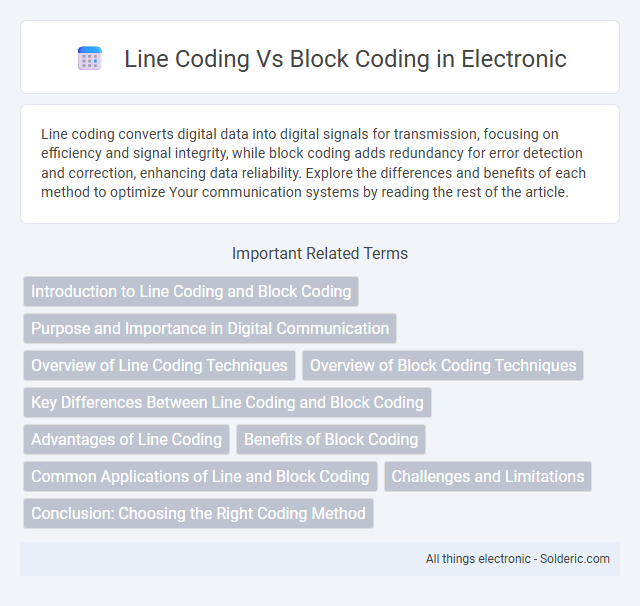Line coding converts digital data into digital signals for transmission, focusing on efficiency and signal integrity, while block coding adds redundancy for error detection and correction, enhancing data reliability. Explore the differences and benefits of each method to optimize Your communication systems by reading the rest of the article.
Comparison Table
| Feature | Line Coding | Block Coding |
|---|---|---|
| Definition | Converts digital data to digital signals for transmission. | Encodes data into fixed-size blocks with error detection/correction. |
| Purpose | Signal representation and synchronization. | Error control and data integrity. |
| Implementation | Transforms bits into signal waveforms (e.g., NRZ, Manchester). | Encodes groups of bits into codewords with redundancy. |
| Error Handling | No inherent error detection; relies on other layers. | Includes error detection and correction capabilities. |
| Complexity | Simple, low processing overhead. | More complex due to encoding and decoding steps. |
| Use Cases | Physical layer signal transmission. | Data link layer error control. |
Introduction to Line Coding and Block Coding
Line coding transforms digital data into electrical signals for transmission over communication channels, optimizing bandwidth and minimizing errors. Block coding, a form of channel coding, encodes fixed-size data blocks using redundant bits to detect and correct errors during data transmission. Both techniques are fundamental in digital communication systems, ensuring data integrity and efficient signal representation.
Purpose and Importance in Digital Communication
Line coding converts digital data into electrical signals for transmission over communication channels, ensuring signal integrity and synchronization. Block coding adds redundancy by grouping bits into blocks, enhancing error detection and correction during data transfer. Your digital communication system benefits from line coding's reliable signal representation and block coding's robust error management to maintain data accuracy and efficiency.
Overview of Line Coding Techniques
Line coding techniques convert digital data into specific signal patterns for efficient transmission over communication channels, with common methods including Non-Return to Zero (NRZ), Return to Zero (RZ), Manchester encoding, and Differential Manchester encoding. These techniques differ in how they represent binary data through voltage levels, signal transitions, and timing, affecting bandwidth usage, synchronization, and error detection capabilities. NRZ is simple and bandwidth-efficient but lacks synchronization features, while Manchester encoding combines clock and data signals for better synchronization at the cost of doubled bandwidth.
Overview of Block Coding Techniques
Block coding techniques transform fixed-size blocks of input bits into longer output codewords to enhance error detection and correction in digital communication. Common block codes include Hamming codes, which can correct single-bit errors, and Reed-Solomon codes, widely used in data storage and transmission for their powerful burst-error correction capabilities. These coding methods improve signal robustness by introducing redundancy, enabling reliable data recovery even in noisy channel conditions.
Key Differences Between Line Coding and Block Coding
Line coding converts digital data into electrical signals for transmission by representing bits as distinct voltage levels or patterns, while block coding adds redundancy by grouping bits into fixed-size blocks for error detection and correction. Line coding schemes like NRZ, Manchester, and RZ focus on signal integrity and synchronization without changing data length, whereas block coding increases data length by encoding fixed-size data blocks into longer codewords to improve reliability. The primary difference lies in line coding's role in physical layer signal representation and block coding's function in enhancing data integrity through error control at higher layers.
Advantages of Line Coding
Line coding offers advantages such as simpler implementation, efficient bandwidth usage, and better synchronization between the transmitter and receiver. It enables easier signal processing and error detection by maintaining a direct correlation between the digital data and the transmitted signal waveform. Your communication system benefits from improved noise immunity and straightforward decoding through these optimized line coding techniques.
Benefits of Block Coding
Block coding improves error detection and correction by grouping data into fixed-size blocks, enhancing data integrity during transmission. It simplifies synchronization and reduces signal distortion compared to line coding, which directly encodes individual bits. Your communication system benefits from increased reliability and efficiency using block coding techniques.
Common Applications of Line and Block Coding
Line coding is commonly used in digital communication systems such as Ethernet, DSL, and optical fiber transmissions to convert digital data into electrical signals for efficient and reliable data transfer. Block coding, including Hamming and Reed-Solomon codes, is frequently applied in data storage devices, satellite communications, and wireless networks to detect and correct errors, thereby improving data integrity. Your choice between line and block coding depends on whether the primary need is signal transmission efficiency or robust error correction.
Challenges and Limitations
Line coding faces challenges such as limited bandwidth efficiency and susceptibility to noise interference, which can degrade signal integrity over long distances. Block coding struggles with increased complexity and latency due to the need for encoding and decoding fixed-size blocks, impacting real-time communication performance. Both methods also encounter limitations in error detection and correction capabilities, affecting overall data transmission reliability.
Conclusion: Choosing the Right Coding Method
Selecting the appropriate line coding or block coding technique depends on factors like bandwidth efficiency, error detection capability, and complexity of implementation. Line coding is ideal for simpler communication systems requiring synchronization and low bandwidth, while block coding offers enhanced error correction and is preferred in noisy environments. Evaluating system requirements and channel conditions ensures optimal data integrity and transmission performance.
Line Coding vs Block Coding Infographic

 solderic.com
solderic.com